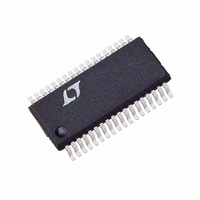LTC3716EG Linear Technology, LTC3716EG Datasheet - Page 16

LTC3716EG
Manufacturer Part Number
LTC3716EG
Description
IC SW REG STP-DN 5BIT SYNC36SSOP
Manufacturer
Linear Technology
Type
Step-Down (Buck)r
Datasheet
1.LTC3716EG.pdf
(28 pages)
Specifications of LTC3716EG
Internal Switch(s)
No
Synchronous Rectifier
Yes
Number Of Outputs
1
Voltage - Output
0.6 ~ 1.75 V
Current - Output
35mA
Frequency - Switching
120kHz ~ 310kHz
Voltage - Input
4 ~ 36 V
Operating Temperature
-40°C ~ 85°C
Mounting Type
Surface Mount
Package / Case
36-SSOP
Lead Free Status / RoHS Status
Contains lead / RoHS non-compliant
Power - Output
-
Available stocks
Company
Part Number
Manufacturer
Quantity
Price
Company:
Part Number:
LTC3716EG
Manufacturer:
KSS
Quantity:
50 000
Part Number:
LTC3716EG
Manufacturer:
LINEAR/凌特
Quantity:
20 000
Part Number:
LTC3716EG#PBF
Manufacturer:
LINEAR/凌特
Quantity:
20 000
Company:
Part Number:
LTC3716EG#TRPBF
Manufacturer:
Linear
Quantity:
736
Part Number:
LTC3716EG#TRPBF
Manufacturer:
LT/凌特
Quantity:
20 000
Company:
Part Number:
LTC3716EG-ES
Manufacturer:
LT
Quantity:
24
Part Number:
LTC3716EGN
Manufacturer:
LT/凌特
Quantity:
20 000
APPLICATIO S I FOR ATIO
LTC3716
INTV
An internal P-channel low dropout regulator produces 5V
at the INTV
regulator powers the drivers and internal circuitry of the
LTC3716. The INTV
peak and must be bypassed to power ground with a
minimum of 4.7 F tantalum or electrolytic capacitor. An
additional 1 F ceramic capacitor placed very close to the
IC is recommended due to the extremely high instanta-
neous currents required by the MOSFET gate drivers.
High input voltage applications in which large MOSFETs
are being driven at high frequencies may cause the maxi-
mum junction temperature rating for the LTC3716 to be
exceeded. The supply current is dominated by the gate
charge supply current, in addition to the current drawn
from the differential amplifier output. The gate charge is
dependent on operating frequency as discussed in the
Efficiency Considerations section. The supply current can
either be supplied by the internal 5V regulator or via the
EXTV
is less than 4.7V, all of the INTV
by the internal 5V linear regulator. Power dissipation for
the IC is higher in this case by (I
efficiency is lowered. The junction temperature can be
estimated by using the equations given in Note 1 of the
Electrical Characteristics. For example, the LTC3716 V
current is limited to less than 24mA from a 24V supply:
Use of the EXTV
The input supply current should be measured while the
controller is operating in continuous mode at maximum
V
prevent the maximum junction temperature from being
exceeded.
EXTV
The LTC3716 contains an internal P-channel MOSFET
switch connected between the EXTV
When the voltage applied to EXTV
internal regulator is turned off and an internal switch
closes, connecting the EXTV
16
IN
T
T
J
J
and the power dissipation calculated in order to
CC
CC
CC
= 70 C + (24mA)(24V)(85 C/W) = 119 C
= 70 C + (24mA)(5V)(85 C/W) = 80.2 C
Regulator
pin. When the voltage applied to the EXTV
Connection
CC
pin from the V
CC
pin reduces the junction temperature to:
CC
U
pin regulator can supply up to 50mA
U
IN
CC
CC
supply pin. The INTV
CC
pin to the INTV
load current is supplied
IN
W
rises above 4.7V, the
)(V
CC
IN
and INTV
– INTV
U
CC
CC
CC
CC
) and
pins.
pin
pin
CC
IN
thereby supplying internal and MOSFET gate driving power
to the IC. The switch remains closed as long as the voltage
applied to EXTV
MOSFET driver and control power to be derived from the
output during normal operation (4.7V < V
from the internal regulator when the output is out of
regulation (start-up, short-circuit). Do not apply greater
than 7V to the EXTV
0.3V when using the application circuits shown. If an
external voltage source is applied to the EXTV
the V
series with the LTC3716’s V
between the EXTV
from backfeeding V
Significant efficiency gains can be realized by powering
INTV
from the driver and control currents will be scaled by the
ratio: (Duty Factor)/(Efficiency). For 5V regulators this
means connecting the EXTV
ever, for 3.3V and other lower voltage regulators, addi-
tional supply circuitry is required to derive INTV
from the output.
The following list summarizes the four possible connec-
tions for EXTV
1. EXTV
to be powered from the internal 5V regulator resulting in
a significant efficiency penalty at high input voltages.
2. EXTV
connection for a 5V regulator and provides the highest
efficiency.
3. EXTV
supply is available in the 5V to 7V range, it may be used to
power EXTV
gate drive requirements.
4. EXTV
For 3.3V and other low voltage regulators, efficiency gains
can still be realized by connecting EXTV
derived voltage which has been boosted to greater than
4.7V but less than 7V. This can be done with either the
inductive boost winding as shown in Figure 5a or the
capacitive charge pump shown in Figure 5b. The charge
pump has the advantage of simple magnetics.
CC
IN
CC
CC
CC
CC
supply is not present, a diode can be placed in
from the output, since the V
left open (or grounded). This will cause INTV
connected to an output-derived boost network.
connected to an external supply. If an external
connected directly to V
CC
CC:
providing it is compatible with the MOSFET
CC
CC
remains above 4.5V. This allows the
CC
IN
and the V
.
pin and ensure that EXTV
CC
IN
pin directly to V
pin and a Schottky diode
IN
pin, to prevent current
OUT
IN
. This is the normal
current resulting
EXTVCC
CC
to an output-
CC
OUT
< 7V) and
CC
pin when
CC
< V
. How-
power
IN
CC
+













